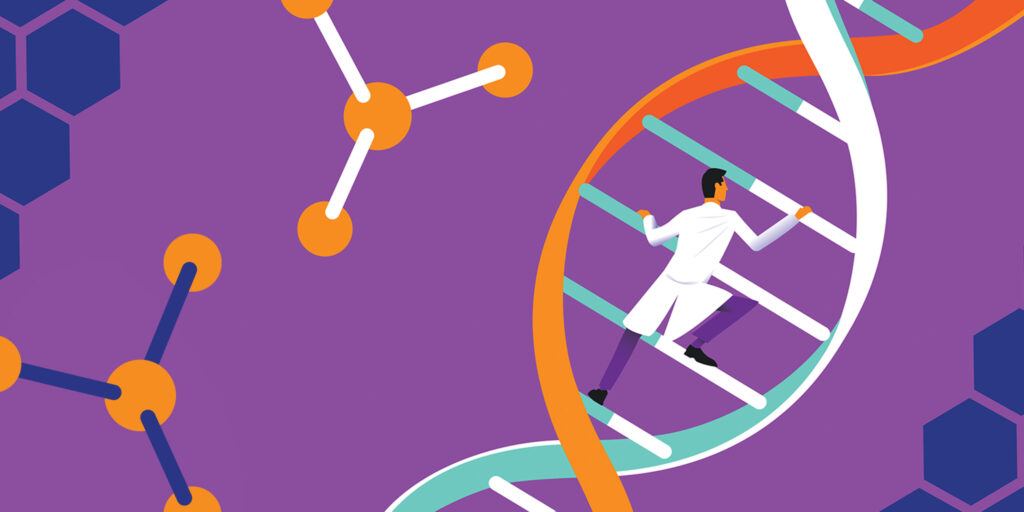
Five Questions With CMT Researcher Stephan Züchner
By MDA Staff | Friday, June 12, 2020
Stephan Züchner, MD, PhD, professor for Human Genetics and Neurology, Chair of the Human Genetics Department, and codirector of the John P. Hussman Institute for Human Genomics at the University of Miami Miller School of Medicine, recently discovered mutations in the sorbitol dehydrogenase gene (SORD) that cause a recessive, axonal form of Charcot-Marie-Tooth disease (CMT) that may be treatable. He published his findings in Nature Genetics.
CMT is the most common inherited peripheral neuropathy, a slowly progressing disease of the peripheral nerves that control muscles. Affecting more than 3 million people worldwide, CMT causes muscle weakness and atrophy with significant variability depending on the type of CMT. Many individuals living with CMT do not receive a genetic diagnosis, even after undergoing advanced testing.
Dr. Züchner was awarded an MDA grant totaling $350,000 over three years to expand an open-access CMT genetics data resource, the GENESIS platform. Taking advantage of this unique resource, Dr. Züchner and colleagues were able to examine sequencing data from more than 1,100 CMT patients to try to identify novel genes associated with the disease. This approach discovered SORD mutations that cause CMT. Because there are already approved drugs for other diseases where the SORD gene is involved, there is strong optimism that this type of CMT could potentially be treatable.
Can you please describe the results from your study?
Supported by the MDA and others, we have discovered that a common, if not the most common, recessive form of peripheral neuropathy is caused by mutations in the SORD gene. “SORD” stands for “sorbitol dehydrogenase,” which is an enzyme that turns the sugar alcohol sorbitol into the sugar molecule fructose. When the SORD enzyme doesn’t function, sorbitol is building up in patients to levels more than 100 times the normal. Importantly, we [know of] a drug that can prevent sorbitol buildup, [which] points to a promising avenue for treatment.
This discovery was substantially enabled by the Inherited Neuropathy Consortium and other physician scientists who have shared data and the spirit of collaboration.
Why are these findings important?
As of today, there is no treatment for any of the forms of CMT. Having the prospect of very promising treatment trials in the near future is great news for patients. We estimate that there are at least 3,000 SORD CMT patients in the USA.
We think this discovery underlines the power of large-scale genomic studies to provide therapeutic options. Given that some 30%-50% of CMT patients still don’t get a diagnosis after advanced testing, the need for better, and in this case actually much larger, genetic studies is evident.
In this regard, the MDA support for the GENESIS CMT genome database has been essential, and continued support will lead to more discoveries.
What are the steps between your discovery and a possible treatment reaching patients?
The fascinating aspect of this study is that it makes the gene discovery, explains the disease mechanism, and also proves in patient cells and in an animal model how to treat it. We are already working on identifying additional patients to study the full clinical spectrum of this new genetic type of neuropathy. Several companies have voiced interest to develop a drug in clinical trials along our suggested pathway. In this unusual case, we might see initial trials going forward in the next 12-18 months — this would be a record time.
What inspired you to study CMT?
Peripheral nerve cells are amongst the most unusual structures in our bodies. Despite their thin and very elongated shape, they are remarkably resilient yet also do get harmed in a substantial portion of the population. Genetic causes of peripheral nerve damage [give researchers] the advantage to truly understand what is at the heart of the disease. Such first principles are important in science. I also think that much of what we discover in the CMT field is applicable to other neurodegenerative diseases — in the brain and nervous system, everything is connected.
What are the major challenges still remaining in CMT research?
First of all, we still don’t have therapies. However, just trying different drugs won’t help in a real way. I think a systematic strategy based on clear genetic evidence will yield therapeutic success for a growing number of CMT subtypes in the next decade. The basis of much of this is a comprehensive genome collection for CMT as we have built within the GENESIS analysis platform. But the current 1,500 genomes are not enough; it will be essential to reach large numbers of at least 10,000 such datasets, combined with clinical data, to make further inroads into rare disease causes, unusual mutations, modifier genes, and more. Having such data available to many scientists with different specialization will be very important.
Disclaimer: No content on this site should ever be used as a substitute for direct medical advice from your doctor or other qualified clinician.




